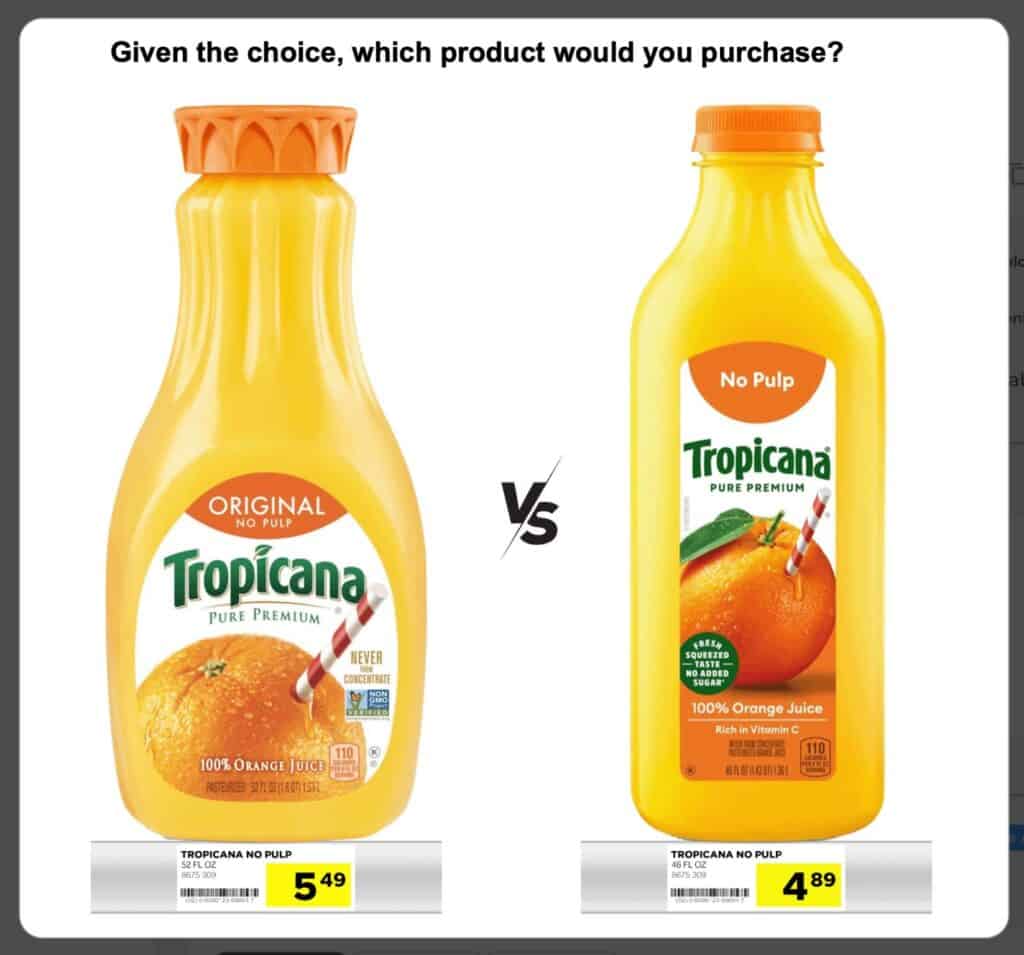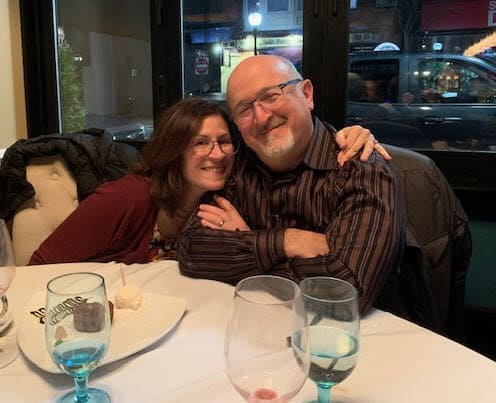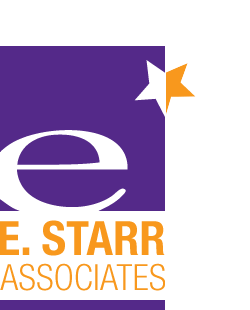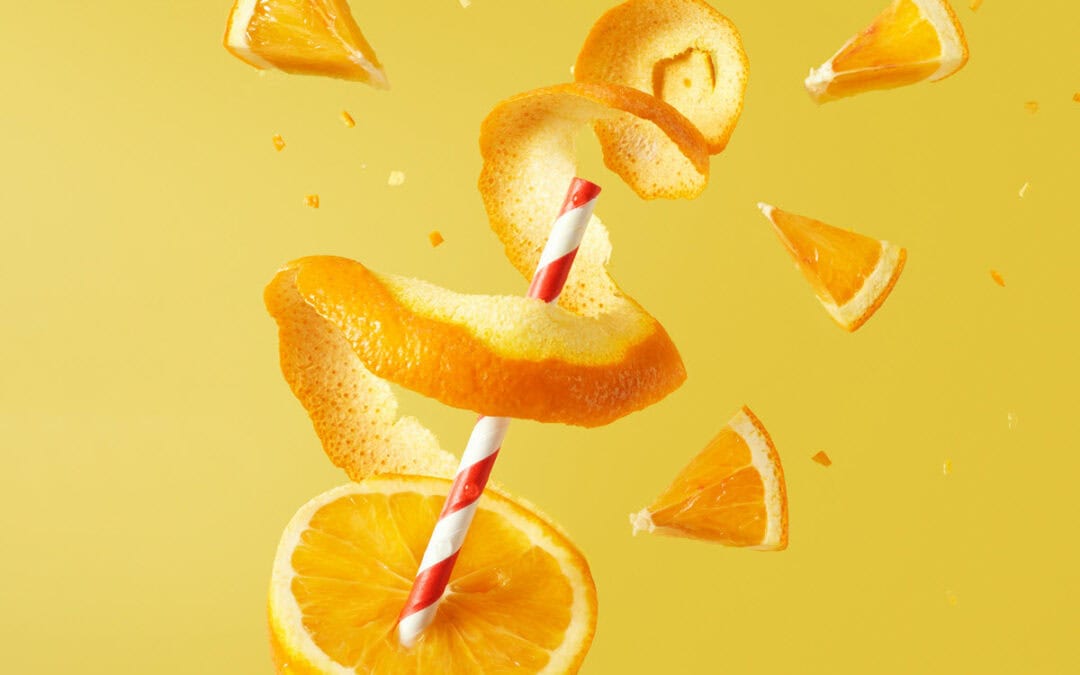Last July Tropicana changed its packaging.
Not in a good way.
Tropicana’s Bottle Redesign Shrinks Package Size and Sales
Tropicana replaced their signature 52-ounce orange juice carafe with a slimmer, 46-ounce, more traditional-looking bottle. The bottle’s smaller girth allowed more facings (bottles to fit on the shelf).
The new bottle required less plastic to make the cap, and was designed to be easier to open, pour, and close.
There was no campaign to announce the change or the benefits.
Customers saw a smaller, more generic bottle in place of the carafe. They were not happy and showed their displeasure by walking away.
Tropicana’s sales fell 8.3% in July from the year prior (per Circana sales data). And they continued to fall.
Sales dropped 10.9% in August and plunged 19% in October. By then Tropicana had ceded 4 percentage points of their market share to competitor Simply Orange.
Why Customers Balked at Tropicana’s New Bottle
While Tropicana recommended a price decrease due to the 6 fewer ounces, some retailers were slow to implement it, leading to media headline cries of shrinkflation.
Shrinkflation accusations may have gained readers’ attention, but it was not consumers’ primary gripe with the change.

Image source: Designalytics
Designalytics Founder and CEO Steve Lamoureux reported that in a study of 2,000 orange juice (OJ) consumers, when asked to choose between the two package options, only 49 (less than 2%) cited shrinkflation among the reasons for their selection.
The shrinkflation-as-driver-of-lost-sales argument fell apart right there.
In the same study Designalytics found:
- 42% opted for the carafe because of its visual appeal
- 19% liked specific structural features of the carafe design
- 10% perceived the carafe to be easier to handle, open, and pour
The carafe’s success since it replaced Tropicana’s carton in 2011 came in part because customers liked the way it looked. Its distinct design made customers happy to use it and have it grace their breakfast tables.
The new bottle’s generic design removed that differentiation and aesthetic.
Consulting Customers Upfront Is Cheaper Than Begging Them to Come Back
A Tropicana spokesperson told CNN the redesign addressed feedback from customers, making it easier to pour and close. While they may have heeded customer feedback on the carafe, it appears they did not seek any on the redesigned bottle.
Tropicana’s spokesperson continued to say, “Changes can take time, and after just a few months, we’re continuing to do what we can to help shoppers get accustomed to our new look.”
If you must address your package change one-on-one with customers, you’re going to lose many who won’t bother to engage.
Hiring Designalytics to conduct consumer research on the bottle before launch would have been exponentially less expensive than Tropicana’s sales loss.
Déjà Vu
This is not Tropicana’s first packaging misfire.
In 2009 the company redesigned their carton with a more generic label. Customers complained and rejected the new look. After 6 weeks of backlash and a 20% decrease in sales ($30 million), Tropicana changed the label back.
All told it is estimated the 2009 failed package change cost the brand $50 million.
At the time, Neil Campbell, president at Tropicana North America, said it was not the volume of complaints that led to the change back. Those were “a fraction of the percent of the people who buy the product.”
Tropicana reversed course, he said, because the criticism came from “our most loyal customers” and “we underestimated the emotional bond” they had with the original package.
He also noted that they were reaching out to every single customer who complained.
Just like Tropicana is doing now.
Avoid Tropicana’s Blind Spot
If Tropicana had communicated the benefits prior to launching the new bottle, would they have stemmed the tide?
We’ll never know, but you can avoid this catastrophic scenario with your brand. Before making a major change:
- Understand what drives your brand’s appeal to your customers, especially your loyal ones, before you design something new. If Tropicana knew 42% of customers liked the carafe’s visual appeal upfront, they may have directed their redesign team to retain that shape.
- Test new initiatives – designs, products, services, formulations – with customers to get feedback. That Tropicana did not invest in consumer insights on their package change to uncover the strong resistance bewilders me. I’m guessing the people involved were either different than in 2009 or failed to think such a backlash could happen again.
- Heed customers’ feedback and adjust as needed. Ignoring it can cost millions.
- Communicate new benefits before and during the launch. Shaping customer understanding upfront can aid adoption. It beats losing customers and having to woo them back one-by-one. And it is way cheaper.
If there is one thing I wish for you to remember from the Varsity Marketing Newsletter, it’s this: There is no substitute for talking to your customers, understanding your brand’s place in their heart, and building on that.
***
My Sabbatical & Future Plans
My sabbatical was not only a celebration of my company’s 25th anniversary, but a needed break. I’d had the sense for a while that it might be time to do something new. But I couldn’t determine what that might be while keeping my business going.
My two guidelines for sabbatical were:
- Break my routines
- Follow my curiosity
Some routines proved harder to break than others. Not going down to my office daily was easy. Shedding the sense that I should be writing or working every morning took weeks.
My curiosity led me to some wonderful experiences and at least one painful one. In addition to spending more time with friends and family, I:
- Fashioned a 4-day writing retreat in the Berkshires where I stayed in a 1735 carriage house
- Attended a WIT (Words, Ideas, and Thinkers) panel discussion between Ruth Reichl and Monica Truong, moderated by Aleksandra Crapanzano
- Heard Mariah Frederiks talk about her book The Wharton Plot at The Mount, Edith Wharton’s home
- Took a book coaching webinar
- Perused an exhibition on the life and work of Guillaume Lethière at The Clark Museum
- Had a mineral bath and massage at the Roosevelt Baths & Spa in Saratoga Springs
- Showed up at book events for 3 author friends
- Went to a World Series game (Yes, the pain is here. No, I don’t want to talk about it.)
- Was awed by The Polonsky Exhibition of the New York Public Library’s Treasures
- Saw Hadestown on Broadway
I read and read and read. I took many short trips.
Small changes I made include:
- Making my browser default page blank instead of the front page of The New York Times
- Consuming less news
- Spending less time on social media overall
It took over 2 months for my brain to recharge and a bit longer before my next path became clear to me.
What’s Next
As I looked to see where my curiosity led me, I realized it was to more time with books and authors.
It is time for me to move on from studying and consulting on brands and marketing. I will be winding down my consulting work over the next few weeks.
I’ve enjoyed finding my voice by writing this newsletter and Teenage Wastebrand. I’m excited to help authors find their voice and share their ideas and insights.
This week I began formal training to be a nonfiction book coach.
I’ve been dabbling with this for a few years now, ever since Mark Schaefer asked me to give him feedback on his manuscript for Cumulative Advantage. We’ve worked together on two more books since then.
My training will take 6-9 months. I’ll be building my book coaching business at the same time.
While marketing will still factor into my work as I help authors understand their readership, query agents, pitch publishers, and promote their books, it will no longer be my core focus.
Which is why this issue will be my last Varsity Marketing newsletter.
You Fabulous Subscribers, You
Thank you for reading my newsletter. I so appreciate your attention, your comments on my blog, your email responses, and the many conversations we’ve had.
Many of you have been with me the whole way, from my first issue 13 years ago this month.
I’ve loved hearing about your experiences and answering your questions. Our interaction has educated me, pushed me further, improved the newsletter, and brought great joy.
Supersized thanks to those who forwarded or shared the newsletter, recommended it, suggested topics, or referred potential clients.
You can continue to find past newsletters here for the next several months.
And if I decide to start another newsletter related to book writing, you’ll be the first to know.
The Varsity Marketing Newsletter may be ending, but my gratitude for your welcoming my issues to your inbox will go on forever.
Additional Gratitude
Thanks to my family for putting up with my penchant for sharing our stories and for allowing me to do so.
Thanks to my daughter Fiona for her help, thoughts, and challenges on the newsletter. Years ago, after I taught Fiona the meaning of the word blanched, she challenged me to use it in a newsletter. I achieved that here.
Thanks to my son AJ for suggesting topics and providing editorial feedback on some issues. After a client requested a meeting on Skype, AJ commented the platform was passé and I should look into that, leading to one of my most popular posts.
And last, but never least, thanks to Dan, my number one supporter, cheerleader, and editor. Also, the love of my life.

Photo credit: David Ossam
***
Just for Fun
Hear the cast of “The Office” serenade Michael Scott with a farewell song, “9,986,000 minutes” (2 minutes)
Enjoy the von Trapp children bidding “So Long, Farewell” from The Sound of Music (2 minutes, 29 seconds)
Thanks again. ❤️


I’m gonna miss my favorite connection to the world of marketing. Enjoy your next career!
Thanks so much Jay! I will miss writing it, but I’ve learned focus is key to making headway. I’m so excited to dive further into book coaching!
I’d expect nothing less of you than this makeover. I wish you success and satisfaction. – a fan
Thank you Ira! You’ve been a steadfast supporter ever since you invited me to speak at the Family Business Center event in Pioneer Valley. Hard to believe that was almost 12 years ago. I appreciate you and your kind wishes.
As someone who is still out here thinking about what’s next, I applaud you!!! Wish I were in Boston to meet for coffee and hear more. All my best in this new adventure!!
Thanks for the applause, Michele! Oh the grass is always greener, right? You are living a fabulous nomadic life and getting to see and experience so much. Hope we can convene somewhere to trade stories, mine of my book coaching journey, and yours of your travels.